Table of Contents
On January 2023, a proposal for a European ban European ban on PFAS under REACH regulation was submitted to the European Chemicals Agency (ECHA) by a group of European countries including the Netherlands, Denmark, Germany, Norway, and Sweden.
This landmark initiative aims to address the risks posed by PFAS, often referred to as "forever chemicals," due to their persistence, bioaccumulation, and potential toxicity.
Two years later, this initiative has become one of the largest chemical restriction projects in EU history, covering over 10,000 PFAS substances across 23 industrial sectors.
The 2025 update of ECHA’s Background Document (Version 14, 20 August 2025) integrates 5,600 + consultation responses and reshapes the regulatory proposal into its near-final form.
The Journey to Restrict PFAS in the EU
- Stage 1: Submission of the Proposal
The process began in January 2023 with the submission of the Annex XV dossier, a comprehensive evaluation of PFAS persistence, mobility, and bioaccumulation. The proposal established the scientific basis for treating PFAS as a “non-threshold chemical group”, meaning any release represents an unacceptable risk due to their extreme persistence and environmental mobility.
- Stage 2: Public Consultation and Evaluation
ECHA opened the six-month consultation in March 2023, receiving over 5 600 stakeholder submissions from industry, NGOs, and academia. The 2025 Background Document now reflects these inputs and expands the scope to eight additional sectors: printing, sealing, machinery, medical packaging/excipients, military and explosives, technical textiles, solvents, and catalysts.
It also defines analytical thresholds for enforcement:
- 25 ppb per individual PFAS
- 250 ppb total PFAS (excluding polymers)
- 50 ppm total fluorine (including polymers)
- Compliance demonstration is required for fluorine content above 50 mg F/kg.
Newly identified PFAS uses include:
-
Sealing applications (pipe linings, gaskets, valve parts)
-
Technical textiles (industrial membranes, outdoor tarpaulins)
-
Printing consumables and permanent components
-
Medical excipients and packaging materials beyond classic devices
-
Stage 3: RAC and SEAC Review
ECHA’s Risk Assessment Committee (RAC) and Socio-Economic Analysis Committee (SEAC) began their technical review in 2024 and continue through 2025.
By September 2025, provisional conclusions include:
- RAC: PFAS use in electronics and semiconductors, risk justification confirmed.
- SEAC: PFAS in energy, lubricants, and fluoropolymer manufacturing, cost-benefit alignment verified.
- Joint focus: manufacturing emissions, threshold methods, and “horizontal” compliance metrics.
Next milestones:
- December 2025: RAC/SEAC deliberation on electronics, semiconductors, manufacturing.
- March 2026: RAC final opinion + SEAC draft → 60-day consultation.
- End 2026: SEAC final opinion → Commission proposal drafting.
- 2027: REACH Committee vote → legal adoption → 18-month enforcement countdown.
What’s Included in the 2025 Restriction Proposal for restricting PFAS under REACH?
To eradicate phenomenal production and usage of PFAS contamination of soil, water, and food sources, posing grave health risks to humans and ecosystems the (REACH) restriction proposal was jointly authored and submitted by five EU member states the Netherlands, Germany, Sweden, Norway, and Denmark. This proposal encompasses over 10,000 PFAS substances and presents two potential restriction options for the sectors mentioned below.
The updated dossier refines the three restriction options:
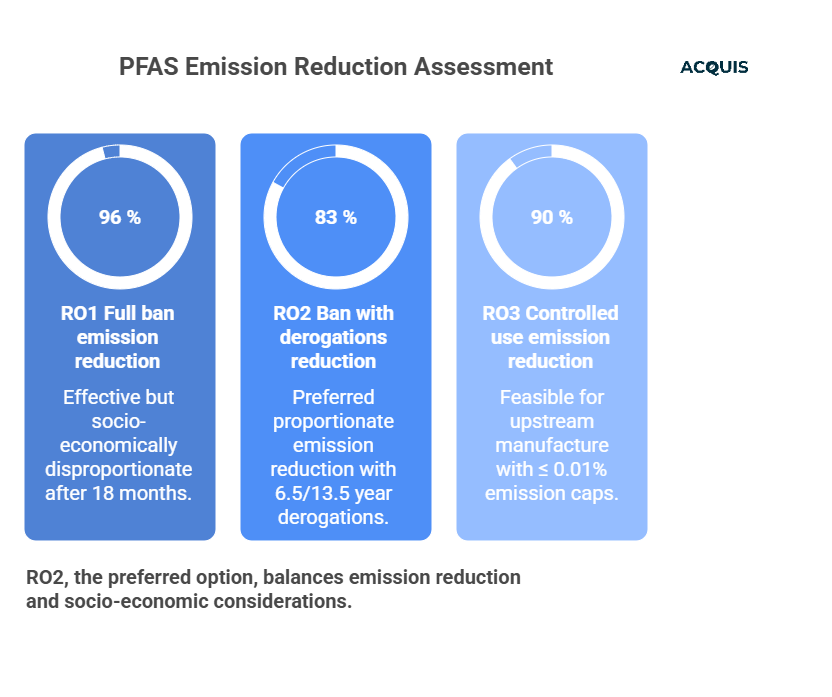
Key Thresholds
- 25 ppb individual PFAS, 250 ppb total, 50 ppm fluorine
- Annual emission ceiling for PFAS manufacturing: ≤ 0.01 % of tonnage (tightening to 0.0036 % by 2030)
Sector Expansion (now 23 industries)
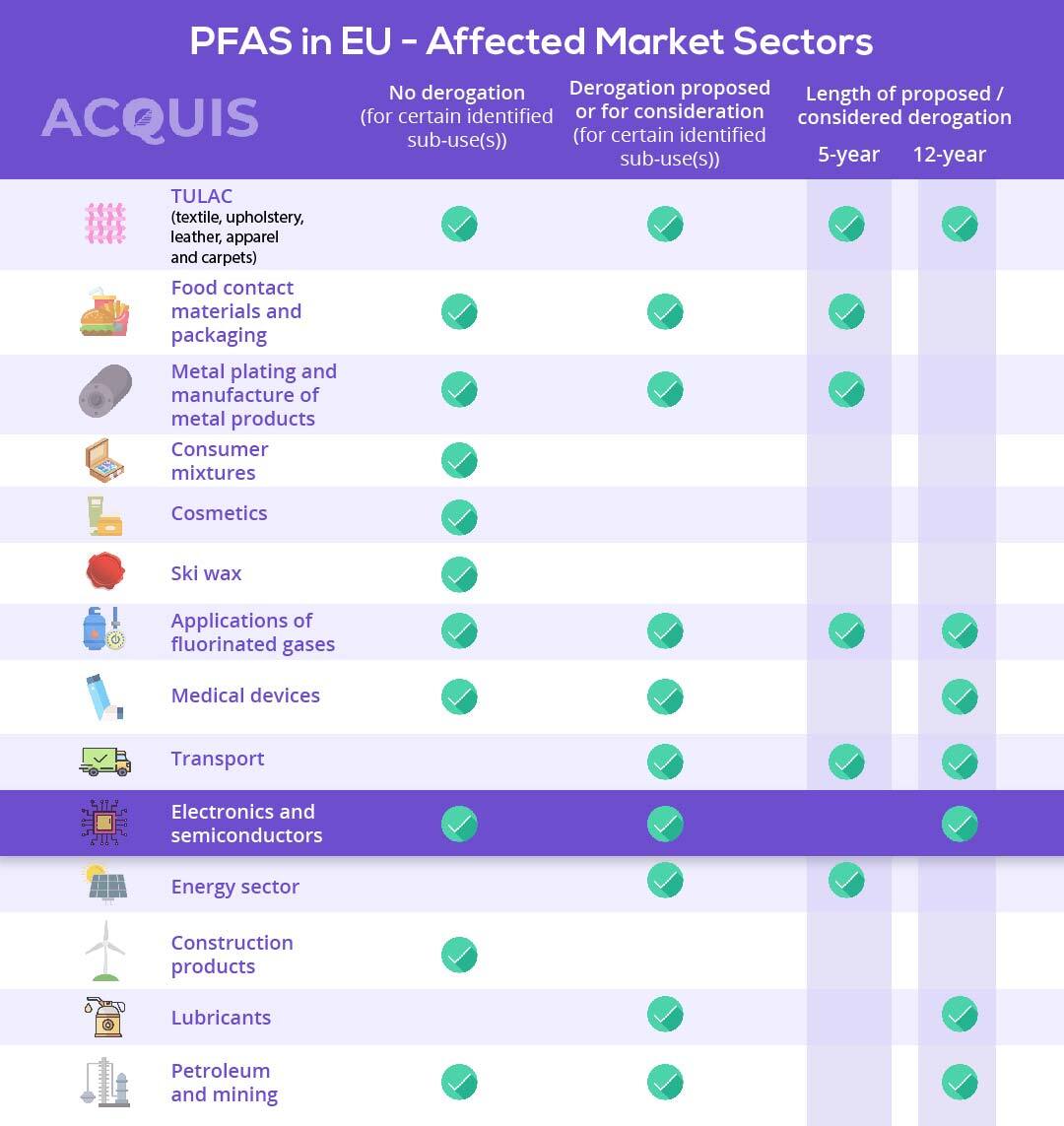
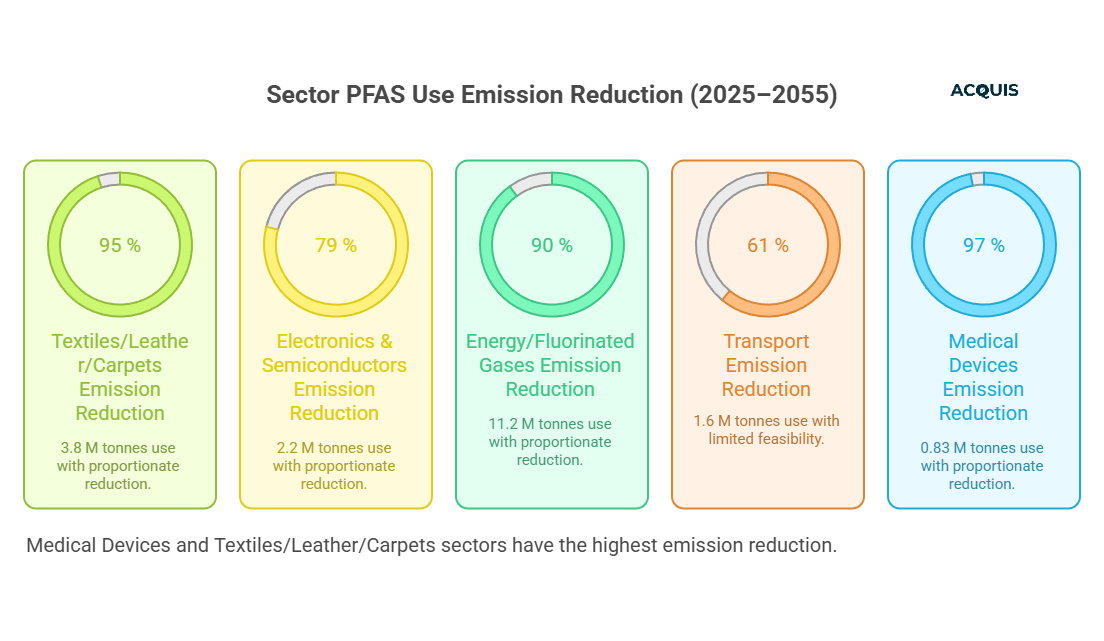
Proposals for Conditional and High-Priority PFAS Restrictions
ECHA also considers conditional allowances under Option 3 (RO3) for sectors where substitution remains technically impossible — such as semiconductors, fluoropolymer production, batteries, fuel cells, and electrolysers. These uses would continue only under mandatory emission controls, lifecycle reporting, and independent verification.
Socio-Economic Measures
- Conditional production and use: allowed with real-time monitoring and lifecycle plans.
- Lifecycle management: emission minimization from manufacture → disposal.
- Derogation periods: 6.5 / 13.5 years tied to alternative readiness.
External Pressures
- NGO stance: ChemTrust and ChemSec call for a universal ban, opposing wide derogations.
- Litigation wave: multiple PFAS lawsuits mirror U.S. class actions, increasing political urgency.
- Industry lobbying: 2025 media reports confirm heavy corporate pressure to narrow PFAS definitions.
National Precedents
Member States continue acting independently:
- Denmark: PFAS-free food packaging (since 2020).
- Germany: PFAS limits in firefighting foams / textiles.
- Netherlands: soil / water PFAS thresholds.
- Sweden: ban on PFAS foams in training.
These unilateral moves preview the enforcement posture of the future EU restriction.
Sectors and Utilizations Where an Immediate Ban is Proposed for PFAS.
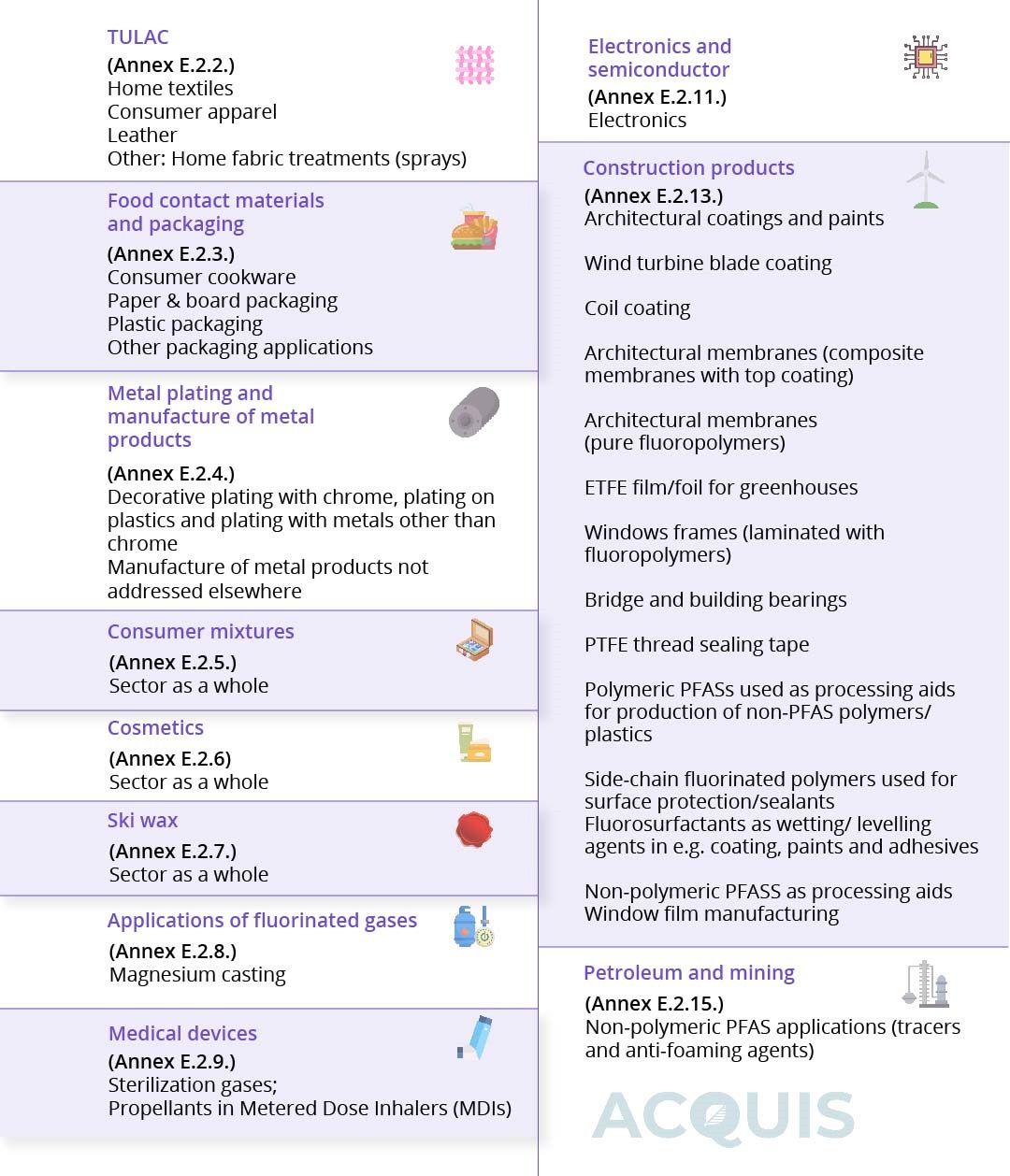
Funding and alternatives: The EU is funding innovation through Horizon Europe and national grants, targeting PFAS-free coatings, repellents, and industrial applications. Despite this, many critical sectors such as semiconductors, defense, and pharma, still lack viable substitutes, making RO3 controlled-use exemptions critical.
Journey of the PFAS Open Public Consultation in EU
PFAS Public-Consultation Timeline of Key Milestones The process of adopting PFAS restrictions is organized into distinct phases:
- March 2023 – September 2023: ECHA conducted a public consultation on the PFAS restriction proposal, receiving over 5,600 responses from stakeholders.
- 2024: The RAC and SEAC began detailed reviews covering consumer mixtures, cosmetics, ski wax, and metal plating.
- September 2024 – March 2025: Assessment phase expanded to include textiles, packaging, food contact materials, petroleum, and mining sectors.
- August 2025: Publication of Version 14 of the restriction dossier, featuring an expanded scope and new threshold limits.
- Q4 2025 – 2026: RAC final opinion and SEAC draft opinion expected, leading to the European Commission’s formal proposal.
- 2027: Member State adoption and the entry into force of the PFAS restriction under REACH, with an 18-month transition period for compliance.
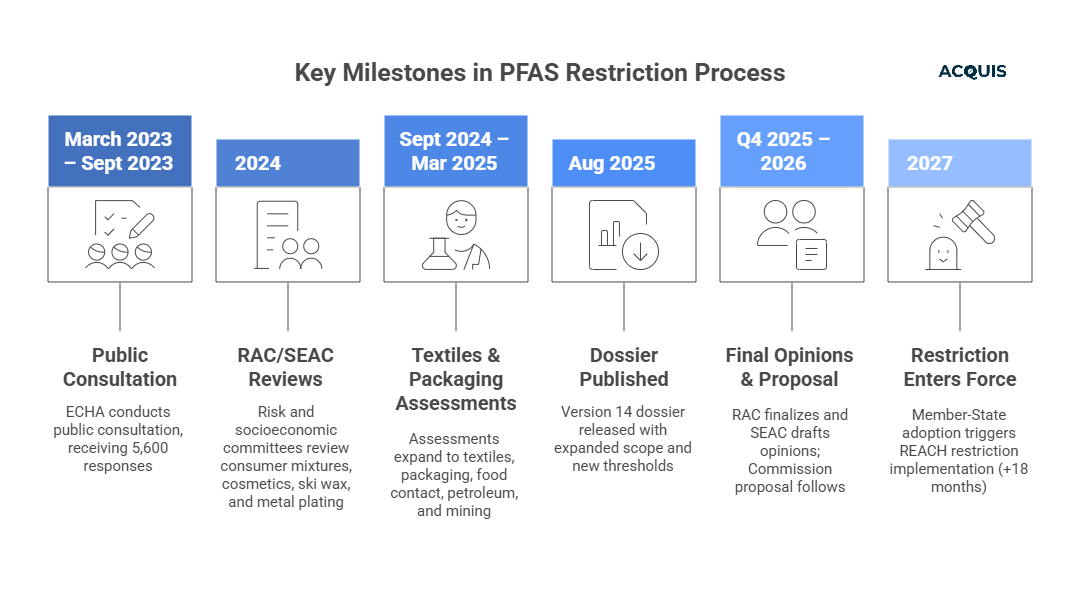
Integration with Broader EU Frameworks
PFAS compliance will also tie into:
- SCIP database (if PFAS classified as SVHC).
- Digital Product Passports (DPPs) for textiles, electronics, and other sectors under the Ecodesign Regulation.
Together, these mechanisms will make PFAS traceability a cross-regulatory digital requirement.
How to Prepare for PFAS Restrictions under EU REACH Regulation
Immediate Actions for Companies
- Map PFAS uses, including polymers, processing aids, coatings, and lubricants.
- Quantify exposure under RO2 / RO3 scenarios (6.5 / 13.5 years).
- Implement supplier declaration workflows and require PFAS disclosure down the chain.
- Build emission-control documentation for any continued use.
- Integrate PFAS data into REACH, SCIP, and DPP systems for future audits.
Strategic Preparation
- Engage with the 2025 RAC/SEAC process. Once closed, no new evidence can shift timelines.
- Treat RO2 + RO3 as the operational baseline; full bans are not politically probable but compliance costs will rise sharply.
Use the derogation windows to phase out at the design level, not just the compliance level.
PFAS Restriction Status (Quick Reference 2025 → 2027)
- Dossier Submission (2023 / 2025 update): Led by Germany, the Netherlands, Denmark, Sweden, and Norway — Completed. Data now consolidated into Version 14 (2025) of the PFAS restriction dossier.
- Public Consultation: Conducted by ECHA — Closed, with 5,600 stakeholder inputs reviewed and integrated.
- Committee Opinions: Managed by RAC and SEAC — Ongoing, with the RAC final opinion expected by March 2026 and SEAC’s draft by end of 2026.
- Commission Proposal: To be issued by the European Commission (DG ENV / REACH Committee) — Pending, anticipated around mid-2026.
- Member-State Adoption & Entry into Force: Handled by the EU REACH Committee —Planned for 2027, with enforcement expected approximately 18 months after adoption.
Bottom line is the science, thresholds, and sector scope are now settled, only the administrative process remains.
Companies waiting for formal enforcement are already behind.
The PFAS restriction under REACH is no longer an early-stage proposal — it’s a regulatory inevitability in its implementation phase.
ECHA’s 2025 update confirms the EU’s direction: zero tolerance for persistent fluorochemicals, with compliance built on traceability, substitution, and digital documentation.
Preparing now is not about avoiding penalties — it’s about ensuring market continuity once PFAS control becomes enforceable law. Talk to our compliance expert to discuss PFAS reporting under REACH regulation.
